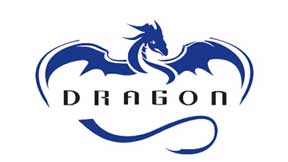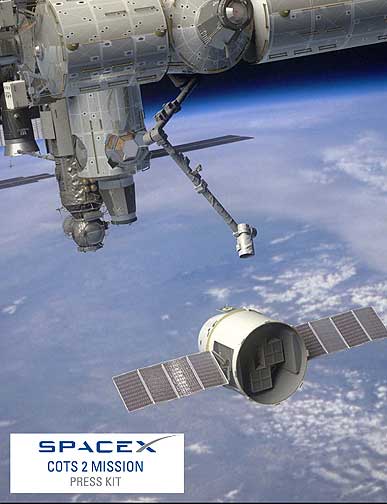"Liftoff ... we've had a cutoff. Liftoff did not occur," said NASA launch commentator George Diller, caught off guard by the sudden, last-minute turn of events. A computer monitoring the rocket's nine engines detected a climbing pressure reading in one engine's chambers and halted the launch 0.5 seconds before liftoff, SpaceX president Gwynne Shotwell told reporters.
The following is an updated dispatch from SpaceX headquarters;
Update on SpaceX COTS 2 Launch
Today’s launch was aborted when the flight computer detected slightly high pressure in the engine 5 combustion chamber. We have discovered root cause and repairs are underway.
During rigorous inspections of the engine, SpaceX engineers discovered a faulty check valve on the Merlin engine. We are now in the process of replacing the failed valve. Those repairs should be complete tonight. We will continue to review data on Sunday. If things look good, we will be ready to attempt to launch on Tuesday, May 22nd at 3:44 AM Eastern.
COTS 2 Demonstration
We stand at the dawn of an exciting new era in space travel: one in which NASA and commercial companies work in partnership to provide rapid advances in space transportation.
This SpaceX mission is a milestone in that transition, marking the first time in history that a commercial company will attempt to send a spacecraft to the International Space Station, something only a few governments have ever accomplished. This is a demonstration mission, a test flight primarily designed to provide NASA and SpaceX with valuable insight to ensure successful future missions.
Mission Highlights
During the mission, Dragon must perform a series of complex tasks, each presenting significant technical challenges (timeline could change):
- Day 1: Launch Day: SpaceX’s Falcon 9 rocket launches a Dragon spacecraft into orbit from the Cape Canaveral Air Force Station.
- Day 2: Dragon orbits Earth as it travels toward the International Space Station.
- Day 3: Dragon’s sensors and flight systems are subject to a series of complicated tests to determine if the vehicle is ready to berth with the space station; these tests include maneuvers and systems checks that see the vehicle come within 1.5 miles of the station.
- Day 4: NASA decides if Dragon is allowed to attempt to berth with the station. If so, Dragon approaches; it is captured by station’s robotic arm and attached to the station. This requires extreme precision even as both Dragon and station orbit the Earth every 90 minutes.
- Day 5—TBD: Astronauts open Dragon’s hatch, unload supplies and fill Dragon with return cargo.
- TBD: After approximately two weeks, Dragon is detached from the station and returns to Earth, landing in the Pacific, hundreds of miles west of Southern California.
 Pushing the Envelope, Success is Not Guaranteed Demonstration launches are conducted to determine potential issues so that they might be addressed and, by their very nature, carry a significant risk.
Pushing the Envelope, Success is Not Guaranteed Demonstration launches are conducted to determine potential issues so that they might be addressed and, by their very nature, carry a significant risk.
All spaceflight is incredibly complicated, and this flight introduces a series of new challenges—it is only the third flight of the Falcon 9 rocket, the second of the Dragon capsule, and the first for a number of all-new components necessary to berth with the International Space Station. If any aspect of the mission is not successful, SpaceX will learn from the experience and try again.
2nd Flight of the NASA COTS Program
This is SpaceX's second demonstration flight under a 2006 Commercial Orbital Transportation Services (COTS) agreement with NASA to develop the capability to carry cargo to and from the International Space Station.
To date, SpaceX has received $381 million for completing 37 out of 40 milestones worth a possible $396 million set in that agreement. Completed milestones include the first test flight in December 2010, during which SpaceX became the first commercial company to send a spacecraft to low-Earth orbit and recover it successfully, something that only three governments – the United States, Russia and China – have ever done.
Next Up
Once SpaceX has successfully demonstrated Dragon’s ability to berth with the space station, it will begin to fulfill a 2008 contract signed with NASA for a minimum of 12 flights carrying supplies to and from the space station.
Without the space shuttle, Dragon is the only spacecraft in the world capable of returning significant cargo from the space station. Falcon 9 and Dragon were designed to carry astronauts in the future; these cargo missions will yield valuable flight experience toward this goal.
SpaceX Demonstration Mission
For the first time in history, a private corporation is set to prove it can deliver cargo to the International Space Station. At the Cape Canaveral Air Force Station, Florida, a Falcon 9 rocket belonging to Space Exploration Technologies (SpaceX), is being prepared to place its Dragon spacecraft into orbit on a test mission to the orbital outpost.
Working for the past six years under NASA’s Commercial Orbital Transportation Services program (COTS), both SpaceX and Orbital Sciences Corp. have been pursuing independent efforts to design, test and fly two brand new cargo vehicles. These will provide the United States with safe, reliable and efficient cargo delivery services to the orbiting complex NASA built with its international partners.
The first COTS demonstration flight that SpaceX completed was in December 2010, where it proved that it could launch, orbit and recover its Dragon spacecraft. Prior to that, the maiden flight of the Falcon 9 demonstrated it could launch a Dragon capsule simulator atop a Falcon 9 rocket. This upcoming mission will prove that Dragon can rendezvous and berth with the International Space Station.
After launching from the Cape Canaveral Air Force Station, Dragon will begin its journey to the space station. Just under 10 minutes after launch, Dragon will reach its preliminary orbit, deploy its solar arrays and begin a carefully choreographed series of engine firings to reach the station. During this part of the flight, Dragon will demonstrate the first set of tests as part of its COTS milestone requirements. The spacecraft will perform a test of its Absolute GPS (AGPS) system, using global positioning system satellites to determine its location.
It also will conduct a free drift demonstration, allowing the spacecraft to float freely with all of its thrusters inhibited. Then Dragon will perform a demonstration of its abort capability, to ensure it could move away from the station if necessary.
On the third day of the flight, Dragon will perform a burn that will bring it to a path 2.5 kilometers (1.5 miles) below the station. During this “fly-under,” Dragon will establish UHF communication with the station using its COTS Ultra-high frequency Communication Unit (CUCU). Dragon will perform a test of its Relative GPS (RGPS) system, which uses the relative positions of the spacecraft to the space station to determine its location. Also, using the crew command panel (CCP) on board the station, the Expedition crew will briefly interact with Dragon, monitoring the fly-under and sending a command to Dragon to turn on its strobe light. This ability for the crew to send commands to Dragon will be important for the next day’s activity. Once the fly-under is complete, Dragon will fire its engines to begin a loop out in front, above and then behind the station in a racetrack pattern at a distance between 7-10 kilometers (4-6.2 miles). This will set the spacecraft up for a re-rendezvous with the station the next day.


